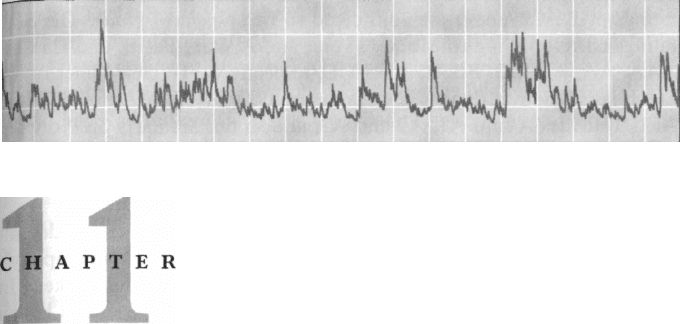Hull J.C. Risk management and Financial institutions
Подождите немного. Документ загружается.


250
Chapter 10
the effect of giving a higher value to the probability that extreme values
for several variables occur simultaneously.
We can assume any set of distributions for the in conjunction with
a copula model.
11
Suppose, for example, that we use a Gaussian copula
model. As explained in Chapter 6, this means that, when the changes
in market variables are transformed on a percentile-to-percentile basis to
normally distributed variables u
i
the u
i
are multivariate normal. We can
follow the five steps given earlier except that Step 2 is changed and a step
is inserted between Steps 2 and 3 as follows:
2. Sample once from the multivariate probability distribution for
the u
i
.
2a. Transform each u
i
to on a percentile-to-percentile basis.
If a bank has already implemented the Monte Carlo simulation approach
for calculating VaR assuming percentage changes in market variables are
normal, it should be relatively easy to modify calculations to implement
the approach we describe here. Just before the portfolio is valued it is
necessary to insert a line or two of code into the computer program to do
the transformation in Step 2a. The marginal distributions of the can
be calculated by fitting a more general distribution than the normal
distribution to empirical data.
10.9 MODEL BUILDING vs. HISTORICAL SIMULATION
In the last chapter and this one, we have discussed two methods for
estimating VaR: the historical simulation approach and the model-build-
ing approach. The advantages of the model-building approach are that
results can be produced very quickly and it can easily be used in
conjunction with volatility and correlation updating schemes such as
those described in Chapters 5 and 6. As mentioned in Section 9.3,
volatility updating can be incorporated into the historical simulation
approach—but in a rather more artificial way. The main disadvantage
of the model-building approach is that (at least in the simplest version of
the approach) it assumes that the market variables have a multivariate
normal distribution. In practice, daily changes in market variables often
have distributions that are quite different from normal (see, for example,
Table 5.2). A user of the model-building approach is hoping that some
See J. Hull and A. White, "Value at Risk When Daily Changes Are Not Normally
Distributed," Journal of Derivatives, 5, No. 3 (Spring 1998), 9-19.

VaR: Model-Building Approach 251
form of the central limit theorem of statistics applies to the portfolio, so
that the probability distribution of daily gains/losses on the portfolio is
normally distributed—even though the gains/losses on the component
parts of the portfolio are not normally distributed.
The historical simulation approach has the advantage that historical
data determines the joint probability distribution of the market variables.
It is also easier to handle interest rates in a historical simulation because
on each trial a complete zero-coupon yield curve for both today and
tomorrow can be calculated. The somewhat messy cash-flow-mapping
procedure described in Section 10.3 is avoided. The main disadvantage
of historical simulation is that it is computationally much slower than the
model-building approach. It is sometimes necessary to use an approxima-
tion such as equation (10.7) when using the historical simulation ap-
proach. This is because a full revaluation for each of the 500 different
scenarios is not possible.
12
The model-building approach is often used for investment portfolios.
(It is after all closely related to the popular Markowitz mean-variance
method of portfolio analysis.) It is less commonly used for calculating the
VaR for the trading operations of a financial institution. This is because,
as explained in Chapter 3, financial institutions like to maintain their
deltas with respect to market variables close to zero. Neither the linear
model nor the quadratic model work well when deltas are low and
portfolios are nonlinear.
SUMMARY
Whereas historical simulation lets the data determine the joint probability
distribution of daily percentage changes in market variables, the model-
building approach assumes a particular form for this distribution. The
most common assumption is that percentage changes in the variables have
a multivariate normal distribution. For situations where the change in the
value of the portfolio is linearly dependent on percentage changes in the
market variables, VaR can be calculated exactly in a straightforward way.
In other situations approximations are necessary. One approach is to use a
quadratic approximation for the change in the value of the portfolio as a
12
This is particularly likely to be the case if Monte Carlo simulation is the numerical
Procedure used by the financial institution to value a deal. Monte Carlo simulations
within historical simulations lead to extremely time-consuming computations.
252
Chapter 10
function of percentage changes in the market variables. Another (much
slower) approach is to use Monte Carlo simulation.
The model-building approach is frequently used for investment port-
folios. It is less popular for the trading portfolios of financial institutions
because it does not work well when deltas are low.
FURTHER READING
Frye, J., "Principals of Risk: Finding VAR through Factor-Based Interest Rate
Scenarios," in VAR: Understanding and Applying Value at Risk, pp. 275-288.
London: Risk Publications, 1997.
Hull, J.C., and A. White, "Value at Risk When Daily Changes in Market
Variables Are Not Normally Distributed," Journal of Derivatives, 5 (Spring
1998): 9-19.
Jamshidian, F., and Y. Zhu, "Scenario Simulation Model: Theory and
Methodology," Finance and Stochastics, 1 (1997): 43-67.
Rich, D., "Second Generation VaR and Risk-Adjusted Return on Capital,"
Journal of Derivatives, 10, No. 4 (Summer 2003): 51-61.
QUESTIONS AND PROBLEMS (Answers at End of Book)
10.1. Consider a position consisting of a $100,000 investment in asset A and a
$100,000 investment in asset B. Assume that the daily volatilities of both
assets are 1 % and that the coefficient of correlation between their returns
is 0.3. What is the 5-day 99% VaR for the portfolio?
10.2. Describe three ways of handling interest-rate-dependent instruments
when the model building approach is used to calculate VaR.
10.3. Explain how an interest rate swap is mapped into a portfolio of zero-
coupon bonds with standard maturities for the purposes of a VaR
calculation.
10.4. A financial institution owns a portfolio of options on the USD/GBP
exchange rate. The delta of the portfolio is 56.0. The current exchange
rate is 1.5000. Derive an approximate linear relationship between the
change in the portfolio value and the percentage change in the exchange
rate. If the daily volatility of the exchange rate is 0.7%, estimate the ten-
day 99% VaR.
10.5. Suppose you know that the gamma of the portfolio in Problem 10.4 is 16.2.
How does this change your estimate of the relationship between the change
in the portfolio value and the percentage change in the exchange rate?
VaR: Model-Building Approach
253
10.6. Suppose that the 5-year rate is 6%, the seven year rate is 7% (both
expressed with annual compounding), the daily volatility of a 5-year zero-
coupon bond is 0.5%, and the daily volatility of a 7-year zero-coupon
bond is 0.58%. The correlation between daily returns on the two bonds is
0.6. Map a cash flow of $1,000 received at time 6.5 years into a position
in a 5-year bond and a position in a 7-year bond. What cash flows in 5
and 7 years are equivalent to the 6.5-year cash flow?
10.7. Verify that the 0.3-year zero-coupon bond in the cash-flow-mapping
example in Table 10.2 is mapped into a $37,397 position in a 3-month
bond and a $11,793 position in a 6-month bond.
10.8. Suppose that the daily change in the value of a portfolio is, to a good
approximation, linearly dependent on two factors, calculated from a
principal components analysis. The delta of a portfolio with respect to
the first factor is 6 and the delta with respect to the second factor is -4.
The standard deviations of the factor are 20 and 8, respectively. What is
the 5-day 90% VaR?
10.9. The text calculates a VaR estimate for the example in Table 4.11
assuming two factors. How does the estimate change if you assume
(a) one factor and (b) three factors.
10.10. A bank has a portfolio of options on an asset. The delta of the options is
-30 and the gamma is -5. Explain how these numbers can be interpreted.
The asset price is 20 and its volatility is 1 % per day. Using the quadratic
model calculate the first three moments of the change in the portfolio
value. Calculate a 1-day 99% VaR using (a) the first two moments and
(b) the first three moments.
10.11. Suppose that in Problem 10.10 the vega of the portfolio is —2 per 1%
change in the annual volatility. Derive a model relating the change in the
portfolio value in 1 day to delta, gamma, and vega. Explain, without doing
detailed calculations, how you would use the model to estimate a VaR.
10.12. Explain why the linear model can provide only approximate estimates of
VaR for a portfolio containing options.
10.13. Some time ago a company entered into a forward contract to buy
£1 million for $1.5 million. The contract now has 6 months to maturity.
The daily volatility of a 6-month zero-coupon sterling bond (when
its price is translated to dollars) is 0.06% and the daily volatility of
a 6-month zero-coupon dollar bond is 0.05%. The correlation between
returns from the two bonds is 0.8. The current exchange rate is 1.53.
Calculate the standard deviation of the change in the dollar value of the
forward contract in 1 day. What is the 10-day 99% VaR? Assume that
the 6-month interest rate in both sterling and dollars is 5% per annum
with continuous compounding.
254
Chapter 1()
ASSIGNMENT QUESTIONS
10.14. Consider a position consisting of a $300,000 investment in gold and a
$500,000 investment in silver. Suppose that the daily volatilities of these
two assets are 1.8% and 1.2% respectively, and that the coefficient of
correlation between their returns is 0.6. What is the 10-day 97.5% VaR
for the portfolio? By how much does diversification reduce the VaR?
10.15. Consider a portfolio of options on a single asset. Suppose that the delta
of the portfolio is 12, the value of the asset is $10, and the daily volatility
of the asset is 2%. Estimate the 1-day 95% VaR for the portfolio from
the delta.
10.16. Suppose you know that the gamma of the portfolio in Problem 10.15 is
-2.6. Derive a quadratic relationship between the change in the portfolio
value and the percentage change in the underlying asset price in 1 day.
(a) Calculate the first three moments of the change in the portfolio value.
(b) Using the first two moments and assuming that the change in the
portfolio is normally distributed, calculate the 1-day 95% VaR for the
portfolio, (c) Use the third moment and the Cornish-Fisher expansion to
revise your answer to (b).
10.17. A company has a long position in a 2-year bond and a 3-year bond as
well as a short position in a 5-year bond. Each bond has a principal of
$100 and pays a 5% coupon annually. Calculate the company's exposure
to the 1-year, 2-year, 3-year, 4-year, and 5-year rates. Use the data in
Tables 4.8 and 4.9 to calculate a 20-day 95% VaR on the assumption that
rate changes are explained by (a) one factor, (b) two factors, and (c) three
factors. Assume that the zero-coupon yield curve is flat at 5%.
10.18. A company has a position in bonds worth $6 million. The modified
duration of the portfolio is 5.2 years. Assume that only parallel shifts
in the yield curve can take place and that the standard deviation of the
daily yield change (when yield is measured in percent) is 0.09. Use the
duration model to estimate the 20-day 90% VaR for the portfolio.
Explain carefully the weaknesses of this approach to calculating VaR
Explain two alternatives that give more accuracy.
10.19. A bank has written a call option on one stock and a put option on
another stock. For the first option the stock price is 50, the strike price is
51, the volatility is 28% per annum, and the time to maturity is 9 months.
For the second option the stock price is 20, the strike price is 19, the
volatility is 25% per annum, and the time to maturity is 1 year. Neither
stock pays a dividend, the risk-free rate is 6% per annum, and the
correlation between stock price returns is 0.4. Calculate a 10-day 99%
VaR (a) using only deltas, (b) using the partial simulation approach, and
(c) using the full simulation approach.

Credit Risk:
Estimating Default
Probabilities
This is the first of three chapters concerned with credit risk. Credit risk
arises from the possibility that borrowers, bond issuers, and counter-
parties in derivatives transactions may default. As explained in Chapter 7,
regulators have for a long time required banks to keep capital for credit
risk. In Basel II, banks can, with approval from bank supervisors, use
their own estimates of default probabilities to determine the amount of
capital they are required to keep. This has led banks to devote a lot of
resources to developing better ways of estimating default probabilities.
In this chapter we discuss a number of different approaches to estimating
default probabilities and explain the key difference between risk-neutral
and real-world estimates. The material we cover will be used in both
Chapters 12 and 13. In Chapter 12 we examine the nature of the credit
risk in over-the-counter derivatives transactions and discuss the calculation
of credit value at risk. In Chapter 13 we cover credit derivatives.
11.1 CREDIT RATINGS
Rating agencies such as Moody's and S&P are in the business of provid-
ing ratings describing the creditworthiness of corporate bonds. Using the
Moody's system, the best rating is Aaa. Bonds with this rating are
considered to have almost no chance of defaulting. The next best rating
is Aa. Following that comes A, Baa, Ba, B, and Caa. Only bonds with

256
Chapter \\
ratings of Baa or above are considered to be investment grade. The S&P
ratings corresponding to Moody's Aaa, Aa, A, Baa, Ba, B, and Caa are
AAA, AA, A, BBB, BB, B, and CCC, respectively. To create finer rating
measures, Moody's divides the Aa rating category into Aal, Aa2, and
Aa3; it divides A into Al, A2 and A3; and so on. Similarly S&P divides
its AA rating category into AA+, AA, and AA-; it divides its A rating
category into A+, A, and A-; and so on. (Only the Aaa category for
Moody's and the AAA category for S&P are not subdivided.)
A credit rating is designed to provide information about default
probabilities. As such one might expect frequent changes in a company's
credit rating as positive and negative information reaches the market.
1
In
fact, ratings change relatively infrequently. When rating agencies assign
ratings, one of their objectives is ratings stability. For example, they want
to avoid ratings reversals where a company is downgraded and then
upgraded a few weeks later. Ratings therefore change only when there
is reason to believe that a long-term change in the company's credit-
worthiness has taken place. The reason for this is that bond traders are
major users of ratings. Often they are subject to rules governing what the
credit ratings of the bonds they hold must be. If these ratings changed
frequently they might have to do a large amount of trading (and incur
high transactions costs) just to satisfy the rules.
A related point is that rating agencies try to "rate through the cycle".
Suppose that the economy exhibits a downturn and this has the effect of
increasing the probability of a company defaulting in the next six months,
but makes very little difference to the company's cumulative probability
of defaulting over the next three to five years. A rating agency would not
change the company's credit rating.
Internal Credit Ratings
Most banks have procedures for rating the creditworthiness of their
corporate and retail clients. This is a necessity. The ratings published
by rating agencies are only available for relatively large corporate clients-
Many small and medium-sized businesses do not issue publicly traded
bonds and therefore are not rated by rating agencies. As explained in
Chapter 7, the internal ratings based (IRB) approach in Basel II allows
banks to use their internal ratings in determining the probability of
1
In theory, a credit rating is an attribute of a bond issue, not a company. However, in
most cases all bonds issued by a company have the same rating. A rating is therefor
often referred to as an attribute of a company.

Credit Risk: Estimating Default Probabilities 257
default, PD. Under the advanced IRB approach, they are also allowed to
use their own internal procedures for estimating the loss given default,
LGD, the exposure at default, EAD, and the maturity, M.
Internal ratings based approaches for PD typically involve profitability
ratios, such as return on assets, and balance-sheet ratios, such as the
current ratio and the debt-to-equity ratio. Banks recognize that it is cash
rather than profits that is necessary to repay a loan. They typically take
the financial information provided by a company and convert it to the
type of cash-flow statement that allows them to estimate how easy it will
be for a company to service its debt.
Altman's Z-Score
Edward Altman has pioneered the use of accounting ratios to predict
default. In 1968 he developed what has become known as the Z-score.
2
Using a statistical technique known as discriminant analysis, he attempted
to predict defaults from five accounting ratios:
X
1
: Working capital/Total Assets
X
2
: Retained earnings/Total assets
X
3
: Earnings before interest and taxes/Total assets
X
4
: Market value of equity/Book value of total liabilities
X
5
: Sales/Total assets
The Z-score was calculated as
If the Z-score is greater than 3.0, the company is unlikely to default. If it is
between 2.7 and 3.0, we should be "on alert". If it is between 1.8 and 2.7,
there is a good chance of default. If it is less than 1.8, the probability of a
financial embarrassment is very high. The Z-score was calculated from a
sample of 66 publicly traded manufacturing companies. Of these, 33 failed
within one year and 33 did not fail. The model proved very accurate when
tested on a sample of firms different from that used to obtain equation
(11.l). Both Type I errors (companies that were predicted not to go
bankrupt but did do so) and Type II errors (companies that were predicted
to go bankrupt, but did not do so) were small.
3
Variations on the model
2
See E.I. Altman, "Financial Ratios, Discriminant Analysis, and the Prediction of
Corporate Bankruptcy," Journal of Finance, 23, No. 4 (September 1968), 589-609.
Clearly Type I errors are much more costly to the lending department of a commercial
bank than Type II errors.

258
Chapter 11
have been developed for manufacturing companies that are not publicly
traded and nonmanufacturing companies.
Example 11.1
Consider a company for which working capital is 170,000, total assets are
670,000, earnings before interest and taxes is 60,000, sales are 2,200,000, the
market value of equity is 380,000, total liabilities is 240,000, and retained
earnings is 300,000. In this case X
1
= 0.254, X
2
= 0.448, X
3
= 0.0896,
X
4
= 1.583, and X
5
= 3.284. The Z-score is
1.2 x 0.254 + 1.4 x 0.448 + 3.3 x 0.0896 + 0.6 x 1.583 + 0.999 x 3.284 = 5.46
The Z-score indicates that the company is not in danger of defaulting in the
near future.
11.2 HISTORICAL DEFAULT PROBABILITIES
Table 11.1 is typical of the data that is produced by rating agencies. It
shows the default experience through time of companies that started with
a certain credit rating. For example, Table 11.1 shows that a bond issue
with an initial credit rating of Baa has a 0.20% chance of defaulting by
the end of the first year, a 0.57% chance of defaulting by the end of the
second year, and so on. The probability of a bond defaulting during a
particular year can be calculated from the table. For example, the
probability that a bond initially rated Baa will default during the second
year of its life is 0.57 - 0.20 = 0.37%.
Table 11.1 shows that, for investment-grade bonds, the probability of
default in a year tends to be an increasing function of time. (For example,
Rating
Aaa
Aa
A
Baa
Ba
B
Caa
1
0.00
0.02
0.02
0.20
1.26
6.21
23.65
Term (years)
2
0.00
0.03
0.09
0.57
3.48
13.76
37.20
3
0.00
0.06
0.23
1.03
6.00
20.65
48.02
4
0.04
0.15
0.38
1.62
8.59
26.66
55.56
5
0.12
0.24
0.54
2.16
11.17
31.99
60.83
7
0.29
0.43
0.91
3.24
15.44
40.79
69.36
10
0.62
0.68
1.59
5.10
21.01
50.02
77.91
15
1.21
1.51
2.94
9.12
30.88
59.21
80.23
20
1.55
2.70
5.24
12.59
38.56
60.73
80.23
Table 11.1 Average cumulative default rates (%), 1970-2003
(Source: Moody's).

Credit Risk: Estimating Default Probabilities 259
the probability of an A-rated bond defaulting during years 1, 2, 3, 4, and 5
are 0.02%, 0.07%, 0.14%, 0.15%, and 0.16%, respectively.) This is
because the bond issuer is initially considered to be creditworthy, and
the more time that elapses, the greater the possibility that its financial
health will decline. For bonds with a poor credit rating, the probability of
default is often a decreasing function of time. (For example, the probabil-
ities that a Caa-rated bond will default during years 1, 2, 3, 4, and 5 are
23.65%, 13.55%, 10.82%, 7.54%, and 5.27%, respectively.) The reason
here is that, for a bond with a poor credit rating, the next year or two may
be critical. If the issuer survives this period, its financial health is likely to
have improved.
Default Intensities
From Table 11.1 we can calculate the probability of a Caa bond default-
ing during the third year as 48.02 - 37.20 = 10.82%. We will refer to this
as the unconditional default probability. It is the probability of default
during the third year as seen at time zero. The probability that the Caa-
rated bond will survive until the end of year 2 is 100 - 37.20 = 62.80%.
The probability that it will default during the third year, conditional on
no earlier default, is therefore 0.1082/0.6280, or 17.23%.
The 17.23% we have just calculated is for a one-year time period. By
considering the probability of default between times t and condi-
tional on no earlier default, we obtain what is known as the default
intensity or hazard rate at time t. The default intensity at time t is
defined so that is the probability of default between time t and
conditional on no default between time 0 and time t. If V(t) is the
cumulative probability of the company surviving to time t (i.e., no default
by time t), then
Taking limits, we obtain
from which we get
or
where is the average default intensity between time zero and time t.
